Weekly wild news from our reserves - 26 November 2021
Sunrise at Lackford Lakes - Joe Bell-Tye
This lovely shot shows a good comparison between our resident swan species, the mute swan and a whooper swan that has dropped into Trimley Marshes recently. Whooper swans are mainly winter visitors to the UK from Iceland, with only a handful breeding in the far north of the UK.
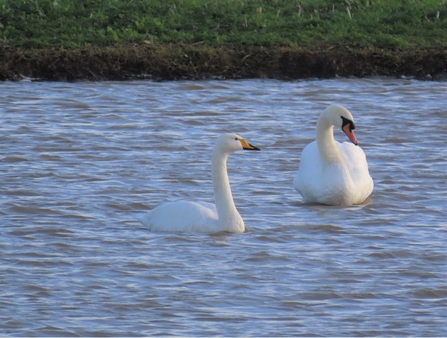
Whooper and mute swans taken by Trimley Marshes volunteer Phil Whittaker
Coppicing, camping and dumplings
Our North and West Suffolk Teams combined forces at Bradfield Woods this week for an epic coppicing session. As the woodland work ran over two days they decided to camp overnight in the centre to reduce their carbon footprint. They even rustled up a feast of game stew with stilton dumplings followed by steamed pudding with cream! Now that's team work!
Double-decker hide nears completion
Our wonderful team of volunteers at Lackford Lakes have been working on creating wheelchair access for lower deck of the new double-decker hide. We hope our new hide will be ready to welcome visitors around Christmas time.
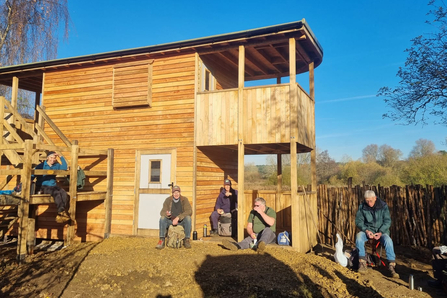
Lackford Lakes volunteers at double-decker hide – Joe Bell-Tye
Pond restoration
Our South Suffolk team restored a pond at Martins' Meadows this week. This needs to be done every few years to avoid the pond being overly shaded and silting up. The first stage was pollarding the oak tree and coppicing the surrounding scrub. Then the digger was used to remove silt build up and fast-growing vegetation like reed mace. The pond will soon refill again naturally.
Dead hedging
Alex and his team at Bradfield Woods National Nature Reserve used the brash and tops of coppiced trees to form a natural barrier around the area being coppiced this winter (coupe – from the French word meaning ‘to cut’) to protect regrowth from browsing by mammals, especially deer. Natural stakes are driven in the ground at intervals with the feathered tops woven between them before longer branches are laid perpendicular facing outwards to limit the high, springing jumps of deer. A traditional skill kept alive at Bradfield with very satisfying results.
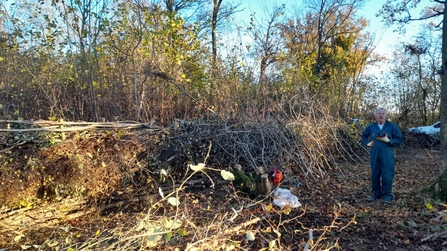
Dead hedging at Bradfield Woods - Alex Lack
Mild weather - late flower
Not usually seen in flower beyond September, this common stork's-bill was spotted doing just that at Lackford Lakes this week. Common stork's-bill is a hairy plant of dry grasslands, and bare and sandy areas, both inland and around the coast. The resulting seed pods are shaped like a crane's bill (hence the name) and explode when ripe, sending the seeds, with their feathery 'parachutes', flying. Common stork's-bill is a sprawling plant, with finely divided, hairy leaves and clusters of pink, five-petalled flowers. Common stork's-bill is one of the foodplants of the caterpillars of the brown argus butterfly.
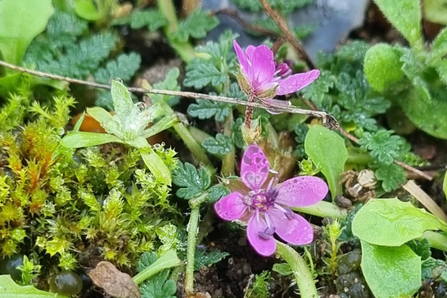
Common stork's-bill – Joe Bell-Tye
Repurposing scrub
Teams at Knettishall Heath and Redgrave & Lopham Fen took advantage of the week’s mild weather by tackling the encroachment of scrub. Many of the habitats we manage benefit enormously by being dotted or fringed with scrubby plants or trees that create structurally diverse ‘edge’ and increase complexity within the ecosystem. Debs Crawford and her team chip the removed biomass on middle fen which is used as a mulch elsewhere off site. Left in situ, stacked up brash provides an extra welcome overwintering refuge for invertebrates and small mammals whilst it slowly starts to break down and rot; another excellent wildlife habitat. The Knettishall team have certainly made a very neat job of it!
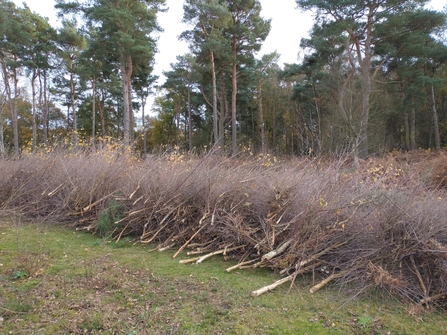
Brash piles at Knettishall Heath - David Stansfeld







